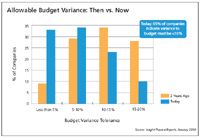Honing Reforms from Clinical Development
Increased efficiency and lower operating costs for both CROs and vendors can be achieved by eliminating activities
Today, despite a history of deep pockets and ample resources, biopharmaceutical and medical device companies face limited financial capital. The current global economy is challenging these companies to operate under modest revenue growth, intense time-to-market pressures, and strong growth in worldwide clinical research spending and activity. In response, companies are placing more demand on their capacity planning and forecasting processes and capabilities and setting lower tolerances for variance between planned and actual performance.
Current industry practices present their own set of challenges. A recent study commissioned by ClearTrial and conducted by the Tufts Center for the Study of Drug Development (Tufts CSDD) indicates that senior managers from clinical development, operations, and outsourcing functions at biopharmaceutical companies believe their capacity planning and forecasting techniques are neither sophisticated nor data driven.
Many organizations report that they are currently relying on institutional knowledge, experience, and "gut feeling" in their planning decisions. Nearly all companies stated that there is wide variability and inconsistency in capacity planning and forecasting practices across various departments and areas within clinical development. Surveyed companies were asked about their capacity planning systems and methodologies. The answers are revealing:
"We do not have a good handle on it now. [Vendors] may be taking us for a ride—we don't know." – Mid-Sized Pharma
"Our models are like putting a finger in the wind. It's not apples to apples, and certainly not 100 percent predictable." – Large Pharma
"We have no costing model and no real forecasting. We send out a request for proposal to CROs and they tell us what they think the costs may be." – Large Pharma
"Honestly, we wing it." – Mid-Sized Pharma
These responses are not too surprising when the most common capacity planning and forecasting methods used in the industry tend to be intuitive and highly unsophisticated. Some of the more "robust" methods at this time include the use of spreadsheets, CRO bids, and the reliance on past experience and intuition.

Allowable Budget Variance: Then vs. Now
Hands down, spreadsheets are reportedly the most common planning and forecasting "system" in use today. Unfortunately for those companies using spreadsheets, there are several major shortcomings with this approach:
1) Difficulty Coordinating Decentralized Global Resources: It's extremely difficult for people working in a decentralized manner, across the globe, to collaborate using a desktop file-based spreadsheet;
2) Difficulty Mining Disparate Spreadsheets for Performance and Capacity Data: It is problematic to mine operational performance history that is scattered across individuals and desktop computers. As a result, spreadsheets are more of a static approach as opposed to a dynamic, routinely updated, and coordinated approach; and
3) Spreadsheets Lack Agility and Consistency: Spreadsheets will give different answers depending on the data inputted, the assumptions made, and who is setting them up and operating them. Today's CFOs and staff involved with planning and forecasting need a consistent and agile approach in order to make informed decisions rapidly.
Facing the growing need to improve their competence in capacity planning and forecasting, some companies are moving to more sophisticated approaches such as commercial databases of prior trials, or third-party planning software based on study tasks. Clearly these new approaches require compatibility with existing systems, processes, and company culture. In addition, they must be intuitive, quick to deploy, and easy to maintain.
As life sciences companies begin to embrace more sophisticated planning and forecasting solutions, a key success factor appears to be giving staff enough time to learn, adopt, and integrate the solution(s). The organization needs to allow sufficient time, and to set clear and measurable goals that define the success of the new solution(s).
Industry Response
Drug development sponsors are beginning to adopt best practices from other industries. These best practices include increasing coordination and centralization of capacity planning and forecasting, and enhancing vendor integration and collaboration.
A growing number of companies are recognizing that resource and capacity planning and management is a strategic competency. Biopharmaceutical and medical device companies are increasingly coordinating and standardizing inputs across functions, and centralizing capacity planning and forecasting activity, typically within clinical operations. Based on interviews with pharmaceutical and biotechnology companies, Tufts CSDD finds that organizations expect to make strong investments in planning and forecasting capabilities in 2011 with the goal of achieving higher performance and reduced variance between planned and actual performance and cost.
The vast majority of companies recognize the need to address inefficiency and fragmented operating structures, as well as the unsophisticated ways that they plan and forecast their capacity and resources. The few companies that are ahead of the curve have centralized their capacity planning and forecasting capabilities and have achieved a higher level of efficiency and coordination across functions.
The importance of company culture cannot be understated. For many years it was easy for pharmaceutical and biotechnology companies to succeed historically with siloed functions and fragmented decision making, in part because the companies were resource rich. In addition, the underlying focus of pharmaceutical and biotechnology companies was on the science of drug development. Over the last decade or so, operating effectiveness and efficiency have entered the management mindset. Only recently, as resources have become far more finite, and economic and operating conditions have become more difficult, are companies being forced to take a step back and approach capacity planning and forecasting in a more rigorous and strategic way.
Integration of Relationships
Tufts CSDD research has noted a rising level of integrated vendor relationships driving program-level and portfolio-level planning and forecasting. A growing proportion of pharmaceutical companies are entering into more extensive relationships with CROs in order to integrate systems and processes and achieve higher levels of efficiency. As such, pharmaceutical companies are sharing more operating risk with their contract service providers.
Key foundational components common to these approaches are:
» Transparency: Prenegotiated billing rates have become more common, and this transparency is moving toward CROs sharing their study approach with sponsors, including staffing, design, and assumptions of effort required.
» Trust: A professional recognition of the other party's needs, replacing the traditional approach of arms-length and heavy-handed demands on supplier approach. Enlightened sponsors recognize that CROs should make a fair profit, while CROs recognize that study sponsors should get lower rates if they can lower the CRO's cost to serve and sell, or else commit to a large number of studies.
» Operational Integration: Many sponsors and CROs are moving to link their systems and share the clinical planning and performance tracking function via a collaborative system, operating as one team. The goal is to increase efficiency and reduce the operating costs for both parties by eliminating duplicate activities.
Given the current state of the drug development enterprise, pharmaceutical and biopharmaceutical companies need to retain a growing collection of variable resources to handle capacity and to provide expertise. More integrated relationships are a key to successfully managing a growing team of resources based internally and externally among full- and niche-service CROs.
Such alignment can pay dividends. Tufts CSDD research has demonstrated that higher levels of CRO usage are associated with faster development speed at comparable quality. Another study revealed that higher growth rates in operating profit are associated with higher levels of outsourcing. In addition, more integrated relationships are associated with faster study startup and higher levels of satisfaction with the sponsor-CRO relationship.
What's in Store
Respondents in the recent Tufts CSDD survey believe that a more standardized approach would go far in establishing more predictable fee-for-service costs that can be compared more easily between contract service providers.
It's clear that capacity planning and forecasting has reached an inflection point—driven in large part by economic and operating conditions, and by the growing reliance on the integration of outsourced capacity. Many companies have implemented, or are in the process of implementing, initiatives to improve and centralize their fragmented capacity planning and forecasting approaches. Finally, the movement to better integrate sponsor-CRO partnerships will help guide efforts to create greater transparency and more coordinated resource allocation and management.
Stella Stergiopoulos is a Project Manager at the Tufts Center for the Study of Drug Development. She can be reached at stella.stergiopoulos@tufts.edu
Ken Getz is a Senior Research Fellow at the Tufts Center for the Study of Drug Development. He can be reached at kenneth.getz@tufts.edu
Mike Soenen is the CEO of ClearTrial. He can be reached at msoenen@cleartrial.com

The Misinformation Maze: Navigating Public Health in the Digital Age
March 11th 2025Jennifer Butler, chief commercial officer of Pleio, discusses misinformation's threat to public health, where patients are turning for trustworthy health information, the industry's pivot to peer-to-patient strategies to educate patients, and more.
Navigating Distrust: Pharma in the Age of Social Media
February 18th 2025Ian Baer, Founder and CEO of Sooth, discusses how the growing distrust in social media will impact industry marketing strategies and the relationships between pharmaceutical companies and the patients they aim to serve. He also explains dark social, how to combat misinformation, closing the trust gap, and more.